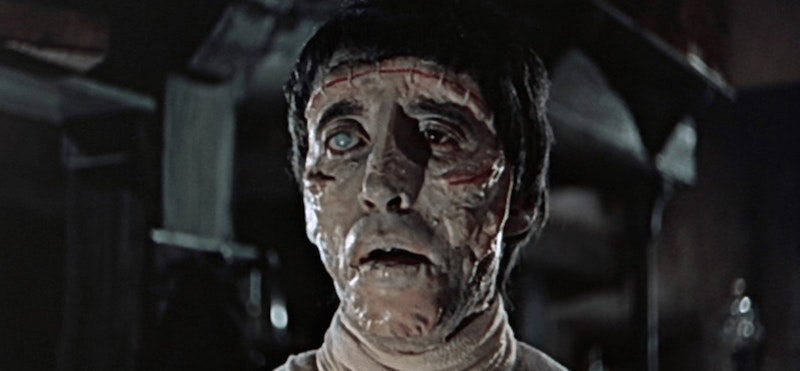When I was a child in Baltimore one of our family rituals was to watch back-to-back horror films every Friday night on a TV show hosted by Sir Graves Ghastly. Sir Graves was a campy-vampire who’d introduce each week’s film and give some details about it after each commercial break. This show reflected a certain zeitgeist centered around the Universal Horror films from the 1930s. This included the fan magazine Famous Monsters of Filmland, Aurora monster model kits, the Dark Shadows TV series and even The Munsters and The Addams Family. These products all reflected a 19th-century Gothic sensibility containing European villages, castles, burgermeisters, humpbacks, etc.
We’d also go to the cinema, specifically one in Hampden. It was there I discovered the Hammer films. Frankenstein, Dracula, The Mummy and The Wolfman were brought out again but this time with gallons of bright red blood, severed heads in baskets, gruesome make-up, on-screen torture and the strong sexual presence of buxom English women. Hammer films were scary in a different, relentless kind of way. I recall a scene in Taste the Blood of Dracula where the mind-controlled henchman of Count Dracula clubs a man over the head and then cuts his throat with a butcher knife, spilling the blood on Dracula’s ashes to revive him from the dead.
It’s interesting to note the sexuality in these films. When I was 10, I recall seeing The House That Screamed, a film about a mama’s boy who uses body parts to create the perfect woman to please his dominating mother. It was set in a girls’ boarding school, had dominatrix-like punishment scenes in the dormitory and suggestive shots of girls in the steamy shower. It was a strange combination of the titillating, the traumatizing and the confusing.
I’d watch these films in terror. Looking back, I don’t think I really liked them, but for whatever reason, I kept watching them, almost against my will. It’s what was happening. I can’t count the number of times I stayed awake at night, wide-eyed in my bed, waiting for some monster to come out from my closet and tear me to pieces. But I kept watching. Only a few times was the experience so intense that I begged my father to leave the theater. This happened when watching The Blob, the 1950s film with Steve McQueen. There was something so inhuman in the scene where the hick farmer gets absorbed by the gelatinous blob that I couldn’t bear it. At least anthropomorphic monsters have a sort of humanity to them.
The saving grace of the early Universal films was that many of them had a philosophical quality, as did the original Frankenstein, which raised questions of scientific hubris, or Count Dracula, representative of a blood sucking aristocracy that never dies. And later films like The Invasion of the Body Snatchers, with its message of people mindlessly following some inhuman directive, still resonate uncannily today.
The classic monster types finally ran their course and fell into decadence, resulting in films like Blacula and Werewolves on Wheels. Advances in make-up and prosthetic techniques, the intensification of psychology and gore-shock that maintained the genre. Now I see movie posters for films like Saw and feel like I understand the experience without needing to step into the cinema.
I haven’t followed horror films for a long time. The last films I saw during the active phase of my interest were Alien, John Carpenter’s The Thing, The Howling and The Texas Chainsaw Massacre. A couple of weeks ago a film-buff friend suggested we go to see Six Women For The Assassin. It wasn’t interesting. However, I realized while watching it that, had I seen it as a child, my mind would’ve made it into a masterpiece of horror.
I lost interest in horror films when I lost interest in participating in my own manipulation. In retrospect I’d say all those sleepless nights I had as a child did bear some fruit, for though I still sometimes lay awake at night, I now understand how the monsters operate.

